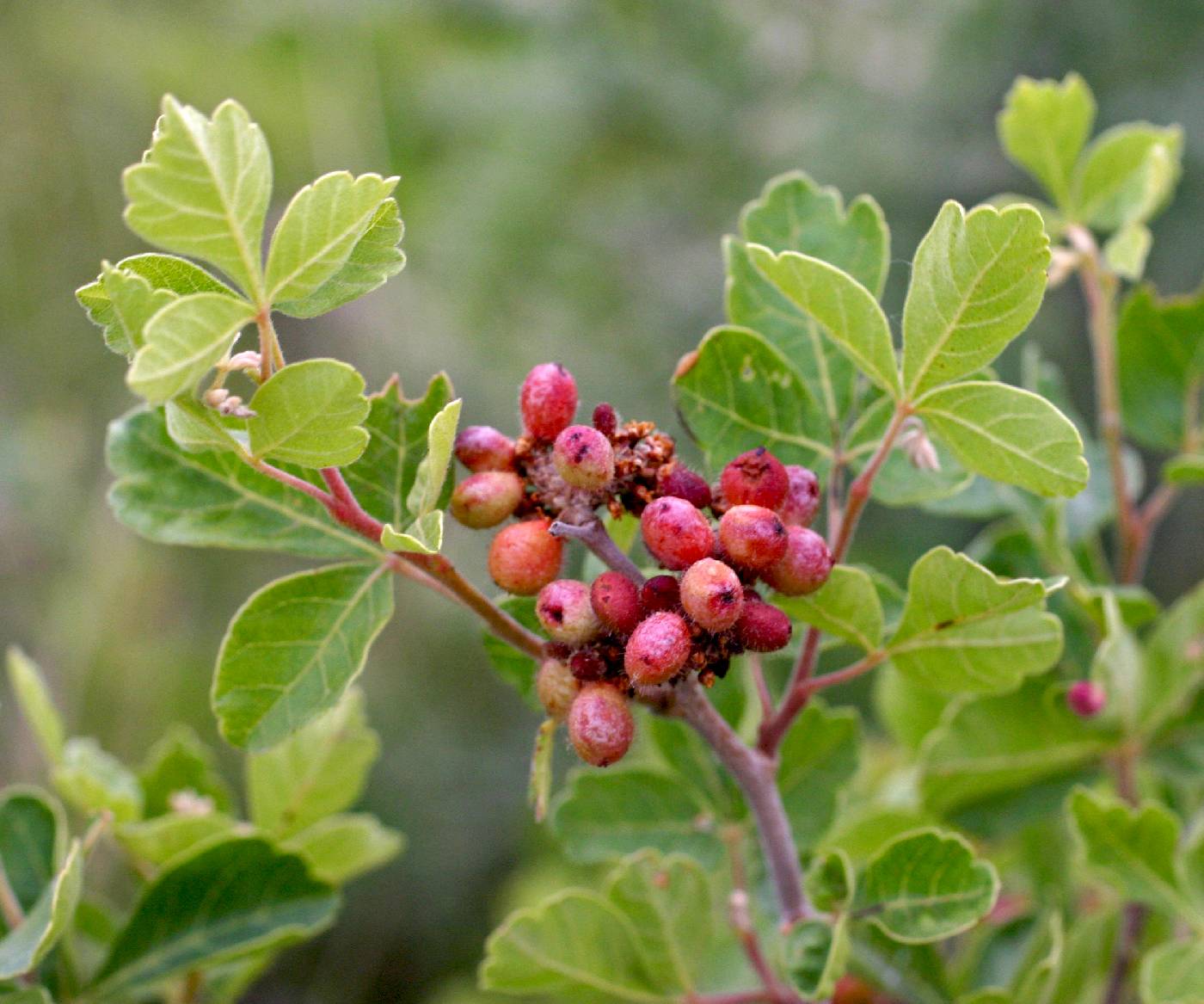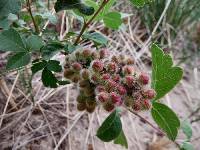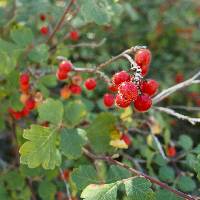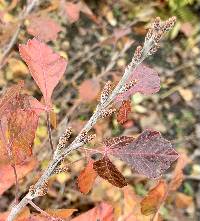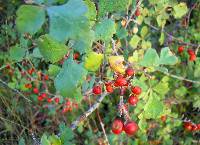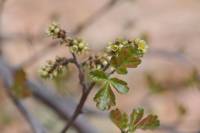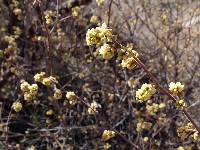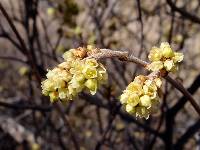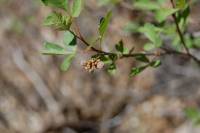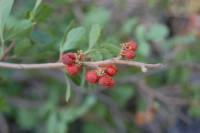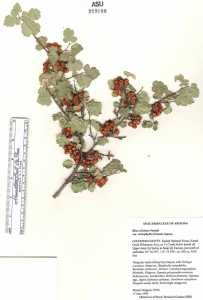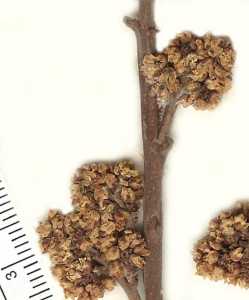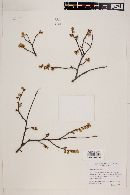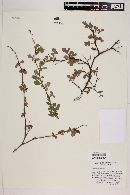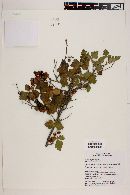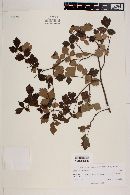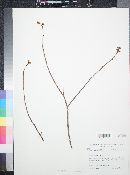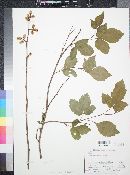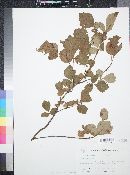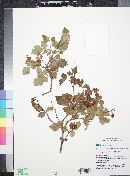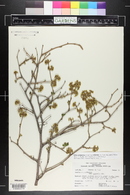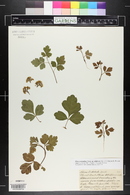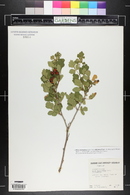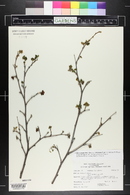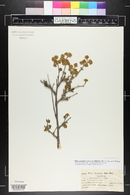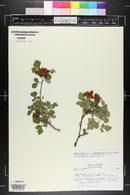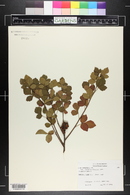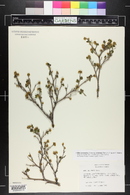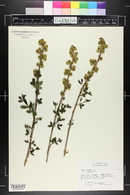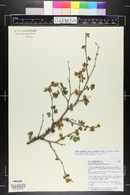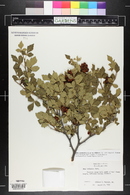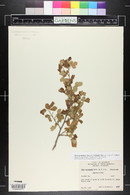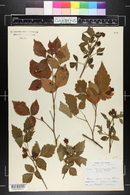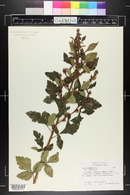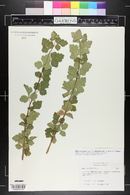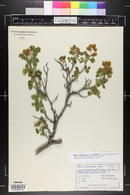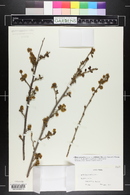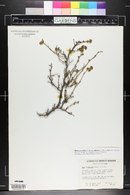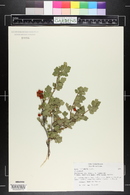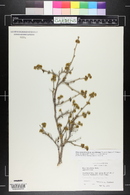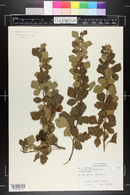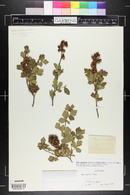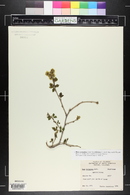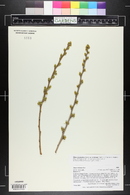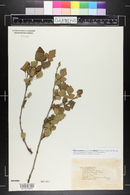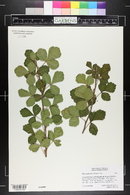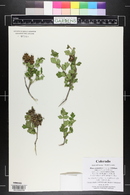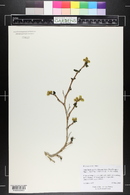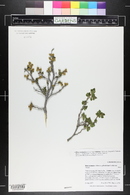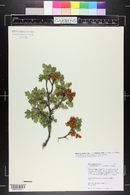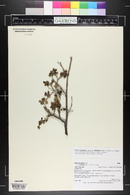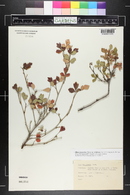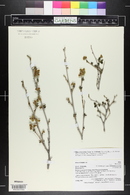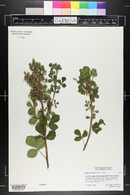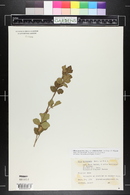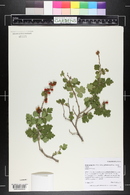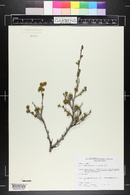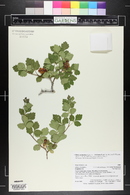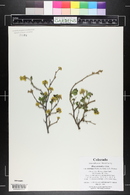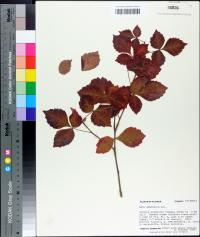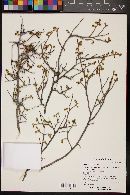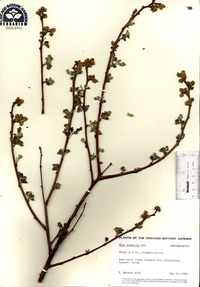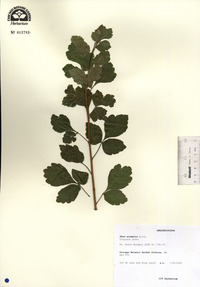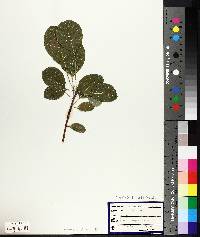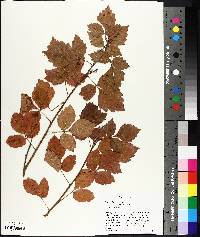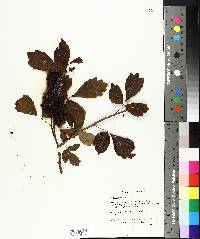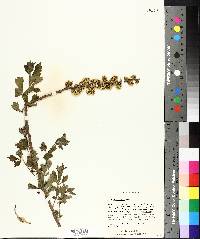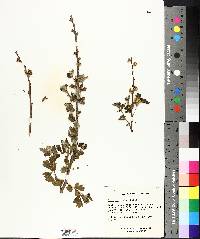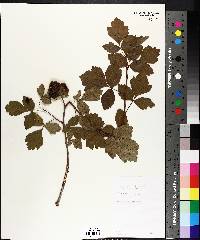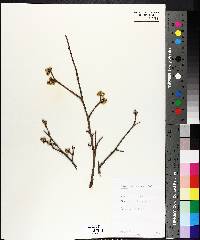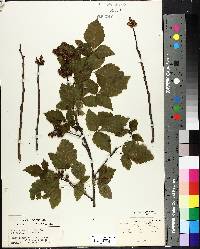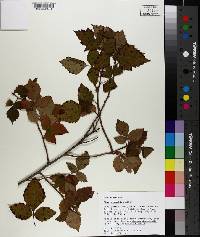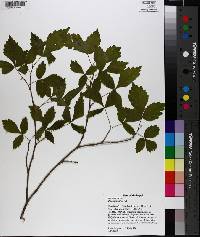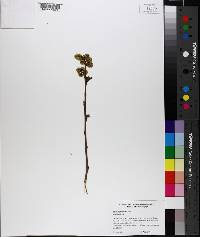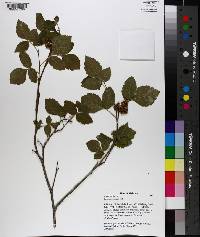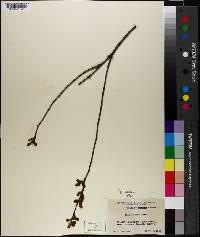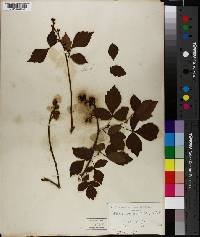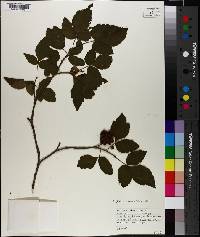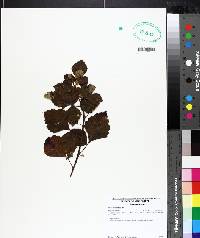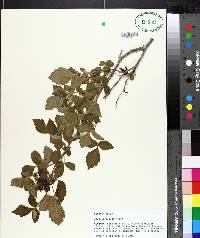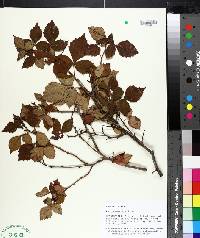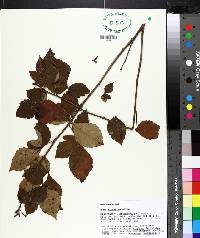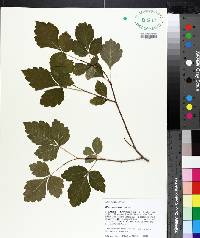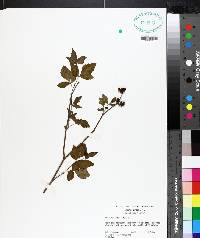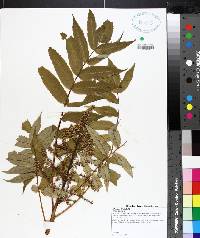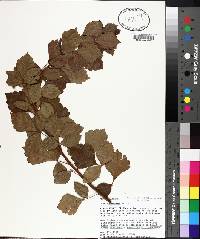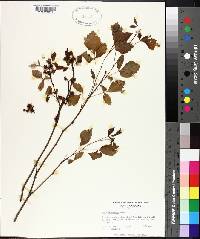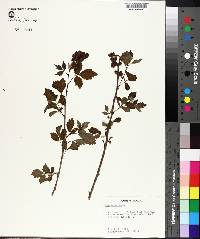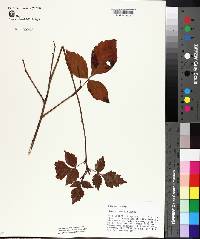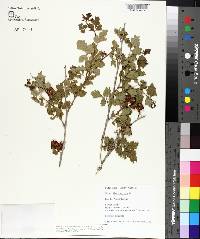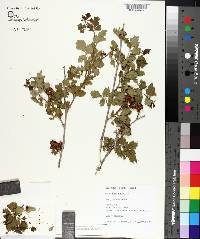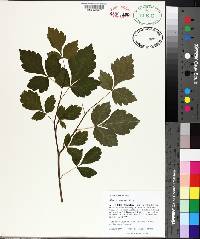Rhus aromatica
|
|
|
|
Family: Anacardiaceae
Fragrant Sumac, more... (es: limita, aigritas)
[Schmaltzia crataegifolia Greene] |
PLANT: Shrubs with spreading branches, sometimes forming thickets, to 3 m tall; bark gray, lenticular; twigs brown, puberulent to glabrate. LEAVES: trifoliolate or palmately lobed to simple and unlobed; petioles 8-15 mm long; leaflets sessile, ovate to rhombic, crenate to deeply lobed, glabrous to puberulent; bases cuneate, sometimes narrowly so; terminal leaflet 15-35 mm long, 7-25 mm wide; foliage thin, deciduous and dark red in the fall. INFLORESCENCE: a short dense panicle of compound spikes, arising from lateral branches, and appearing early before the leaves in the spring, 10-15 mm long; bracts triangular, reddish, pubescent. FLOWERS: to 3 mm long; sepals ovate, pinkish, glabrate; petals obovate, pale yellow, glabrous. FRUIT: lenticular-orbicular, 6-8 mm in diameter, dull orange to dark reddish, villous and/or short glandular pubescent, viscid. NOTES: Throughout the U.S., except the northern Great Lakes and Pacific Northwest, also s Canada and n Mex. REFERENCES: John L. Anderson, 2006, Vascular Plants of Arizona: Anacardiaceae. CANOTIA 3 (2): 13-22. Shrub highly variable, 0.6 - 2 m tall, spreading 1.8 - 3 m Leaves: alternate, stalked, with three leaflets (trifoliate). Leaves are aromatic when rubbed. Flowers: either male or female, borne on separate plants (dioecious), or with some bisexual flowers (polygamous), pale yellow, borne at ends of branches, with male flowers in 2.5 cm catkins and female flowers in short spike-like clusters. Male catkins persist through winter. Fruit: fleshy with a center stone (drupe), 4 - 5 mm long, bright red, densely hairy, sometimes persisting into winter but losing color. Twigs: highly branched, slender, hairy, aromatic when rubbed, with circular, raised leaf scars. Buds: yellow, tiny, hairy, surrounded by a leaf scar. Leaflets: very short-stalked or stalkless, medium green, often glossy above, egg-shaped, coarsely toothed, with a lower surface that is hairy when young. The terminal leaflet is 1.5 - 8 cm long, elliptic to four-sided or inversely egg-shaped with a pointed or blunt to rounded tip and a wedge-shaped base. Lateral leaflets about half the size of terminal leaflets. Fall color is orange to red to reddish purple. Similar species: Rhus aromatica is represented by two varieties in the Chicago Region. See links below for further information. Its strong scent and glossy, distinctly shaped trifoliate leaves make it easy to identify in the Chicago Region. Occurence in the Chicago region: native Notes: The cultivar 'Gro-low' only reaches 2' tall and makes a nice groundcover. It roots from stems that contact the soil, tolerates poor soils, and is commonly planted on slopes to prevent erosion. Etymology: Rhus is the Greek name for a species of sumac. Aromatica means aromatic. Author: The Morton Arboretum Anderson 2007, Benson and Darrow 1981, Kearney and Peebles 1969 Common Name: fragrant sumac Duration: Perennial Nativity: Native Lifeform: Shrub Wetland Status: FACU General: Shrub with spreading branches, sometimes in thickets reaching 3 m tall; gray, lenticular bark; brown, puberulent to glabrate. Leaves: Trifoliate to palmately lobed, to simple and unlobed; 8-15 mm petioles, cuneate bases, sometimes narrowly so, terminal leaflet 15-35 mm long, 7-25 mm wide, thin, deciduous, reddish in fall. Flowers: Ovate pinkish sepals, obovate pale yellow petals, to 3 mm long. Fruits: Lenticular-orbicular berry, 6-8 mm in diameter, dull orange to dark reddish, villous to short glandular pubescent. Ecology: Found on dry slopes and in canyons, often among chaparral from 2,500-7,500 ft (762-2286 m); flowers March-August. Distribution: Most of N.America; from Alberta, CAN, south to s CA, east to MD; south to s MEX. Ethnobotany: Bark and berries used medicinally, leaves were smoked, used for stomachaches, for itching, Fruit sour but edible, often mixed with water for a refreshing beverage. Also made into jam, prepared with meat, made into cakes, and even ground into a meal, after drying in the sun and used as flour and stored. Wild and tended forms very different, so that tended shrubs have long, straight shoots used in basketry. Etymology: Rhus is derived from rhous, a Greek work for sumac, while aromatica means fragrant. Synonyms: None Editor: SBuckley, 2010 Malodorous, frequently branched, rounded shrubs to 2 m, often forming thickets; lfls 3, sessile or nearly so, at least the terminal one few-toothed or -cleft above the middle; fls pale yellow, in several short (1-2 cm), spike-like lateral clusters formed from axillary buds in late summer the previous year and expanding with (or just after) or before the lvs in the spring; frs 4-5 mm, bright red, densely hairy. Open woods, sand-dunes, and other open places; sw. Que. and w. Vt. to nw. Fla., w. to Alta., Oreg., Calif., and Mex. (R. trilobata) Variable, with 4 vars. in our range. Gleason, Henry A. & Cronquist, Arthur J. 1991. Manual of vascular plants of northeastern United States and adjacent Canada. lxxv + 910 pp. ©The New York Botanical Garden. All rights reserved. Used by permission. From Flora of Indiana (1940) by Charles C. Deam Two varieties occur in Indiana: var. aromatica is widespread in the state, while var. arenaria is limited to the dunes of Lake Michigan shore. See the variety descriptions for more details. Diagnostic Traits: aromatic, much branched shrubs with 3-foliate leaves; flowers in short, subglomerate, lateral spikes; drupes red-hairy. |
|
|
|

